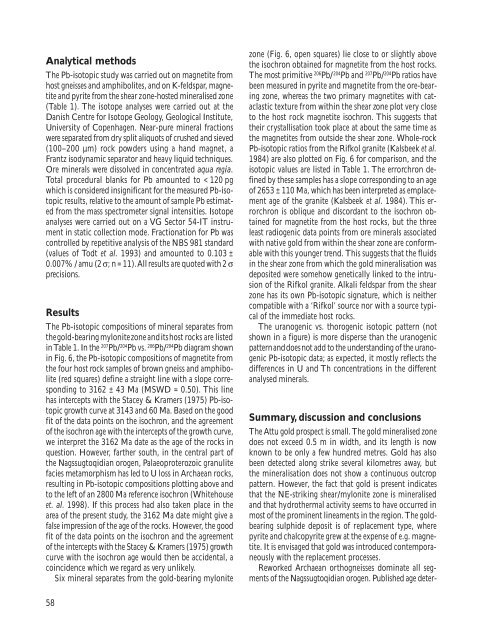Geological Survey of Denmark and Greenland Bulletin 11 ... - GEUS
Geological Survey of Denmark and Greenland Bulletin 11 ... - GEUS
Geological Survey of Denmark and Greenland Bulletin 11 ... - GEUS
Create successful ePaper yourself
Turn your PDF publications into a flip-book with our unique Google optimized e-Paper software.
Analytical methods<br />
The Pb-isotopic study was carried out on magnetite from<br />
host gneisses <strong>and</strong> amphibolites, <strong>and</strong> on K-feldspar, magnetite<br />
<strong>and</strong> pyrite from the shear zone-hosted mineralised zone<br />
(Table 1). The isotope analyses were carried out at the<br />
Danish Centre for Isotope Geology, <strong>Geological</strong> Institute,<br />
University <strong>of</strong> Copenhagen. Near-pure mineral fractions<br />
were separated from dry split aliquots <strong>of</strong> crushed <strong>and</strong> sieved<br />
(100–200 µm) rock powders using a h<strong>and</strong> magnet, a<br />
Frantz isodynamic separator <strong>and</strong> heavy liquid techniques.<br />
Ore minerals were dissolved in concentrated aqua regia.<br />
Total procedural blanks for Pb amounted to < 120 pg<br />
which is considered insignificant for the measured Pb-isotopic<br />
results, relative to the amount <strong>of</strong> sample Pb estimated<br />
from the mass spectrometer signal intensities. Isotope<br />
analyses were carried out on a VG Sector 54-IT instrument<br />
in static collection mode. Fractionation for Pb was<br />
controlled by repetitive analysis <strong>of</strong> the NBS 981 st<strong>and</strong>ard<br />
(values <strong>of</strong> Todt et al. 1993) <strong>and</strong> amounted to 0.103 ±<br />
0.007% / amu (2 σ; n = <strong>11</strong>). All results are quoted with 2 σ<br />
precisions.<br />
Results<br />
The Pb-isotopic compositions <strong>of</strong> mineral separates from<br />
the gold-bearing mylonite zone <strong>and</strong> its host rocks are listed<br />
in Table 1. In the 207 Pb/ 204 Pb vs. 206 Pb/ 204 Pb diagram shown<br />
in Fig. 6, the Pb-isotopic compositions <strong>of</strong> magnetite from<br />
the four host rock samples <strong>of</strong> brown gneiss <strong>and</strong> amphibolite<br />
(red squares) define a straight line with a slope corresponding<br />
to 3162 ± 43 Ma (MSWD = 0.50). This line<br />
has intercepts with the Stacey & Kramers (1975) Pb-isotopic<br />
growth curve at 3143 <strong>and</strong> 60 Ma. Based on the good<br />
fit <strong>of</strong> the data points on the isochron, <strong>and</strong> the agreement<br />
<strong>of</strong> the isochron age with the intercepts <strong>of</strong> the growth curve,<br />
we interpret the 3162 Ma date as the age <strong>of</strong> the rocks in<br />
question. However, farther south, in the central part <strong>of</strong><br />
the Nagssugtoqidian orogen, Palaeoproterozoic granulite<br />
facies metamorphism has led to U loss in Archaean rocks,<br />
resulting in Pb-isotopic compositions plotting above <strong>and</strong><br />
to the left <strong>of</strong> an 2800 Ma reference isochron (Whitehouse<br />
et. al. 1998). If this process had also taken place in the<br />
area <strong>of</strong> the present study, the 3162 Ma date might give a<br />
false impression <strong>of</strong> the age <strong>of</strong> the rocks. However, the good<br />
fit <strong>of</strong> the data points on the isochron <strong>and</strong> the agreement<br />
<strong>of</strong> the intercepts with the Stacey & Kramers (1975) growth<br />
curve with the isochron age would then be accidental, a<br />
coincidence which we regard as very unlikely.<br />
Six mineral separates from the gold-bearing mylonite<br />
zone (Fig. 6, open squares) lie close to or slightly above<br />
the isochron obtained for magnetite from the host rocks.<br />
The most primitive 206 Pb/ 204 Pb <strong>and</strong> 207 Pb/ 204 Pb ratios have<br />
been measured in pyrite <strong>and</strong> magnetite from the ore-bearing<br />
zone, whereas the two primary magnetites with cataclastic<br />
texture from within the shear zone plot very close<br />
to the host rock magnetite isochron. This suggests that<br />
their crystallisation took place at about the same time as<br />
the magnetites from outside the shear zone. Whole-rock<br />
Pb-isotopic ratios from the Rifkol granite (Kalsbeek et al.<br />
1984) are also plotted on Fig. 6 for comparison, <strong>and</strong> the<br />
isotopic values are listed in Table 1. The errorchron defined<br />
by these samples has a slope corresponding to an age<br />
<strong>of</strong> 2653 ± <strong>11</strong>0 Ma, which has been interpreted as emplacement<br />
age <strong>of</strong> the granite (Kalsbeek et al. 1984). This errorchron<br />
is oblique <strong>and</strong> discordant to the isochron obtained<br />
for magnetite from the host rocks, but the three<br />
least radiogenic data points from ore minerals associated<br />
with native gold from within the shear zone are conformable<br />
with this younger trend. This suggests that the fluids<br />
in the shear zone from which the gold mineralisation was<br />
deposited were somehow genetically linked to the intrusion<br />
<strong>of</strong> the Rifkol granite. Alkali feldspar from the shear<br />
zone has its own Pb-isotopic signature, which is neither<br />
compatible with a ‘Rifkol’ source nor with a source typical<br />
<strong>of</strong> the immediate host rocks.<br />
The uranogenic vs. thorogenic isotopic pattern (not<br />
shown in a figure) is more disperse than the uranogenic<br />
pattern <strong>and</strong> does not add to the underst<strong>and</strong>ing <strong>of</strong> the uranogenic<br />
Pb-isotopic data; as expected, it mostly reflects the<br />
differences in U <strong>and</strong> Th concentrations in the different<br />
analysed minerals.<br />
Summary, discussion <strong>and</strong> conclusions<br />
The Attu gold prospect is small. The gold mineralised zone<br />
does not exceed 0.5 m in width, <strong>and</strong> its length is now<br />
known to be only a few hundred metres. Gold has also<br />
been detected along strike several kilometres away, but<br />
the mineralisation does not show a continuous outcrop<br />
pattern. However, the fact that gold is present indicates<br />
that the NE-striking shear/mylonite zone is mineralised<br />
<strong>and</strong> that hydrothermal activity seems to have occurred in<br />
most <strong>of</strong> the prominent lineaments in the region. The goldbearing<br />
sulphide deposit is <strong>of</strong> replacement type, where<br />
pyrite <strong>and</strong> chalcopyrite grew at the expense <strong>of</strong> e.g. magnetite.<br />
It is envisaged that gold was introduced contemporaneously<br />
with the replacement processes.<br />
Reworked Archaean orthogneisses dominate all segments<br />
<strong>of</strong> the Nagssugtoqidian orogen. Published age deter-<br />
58
















